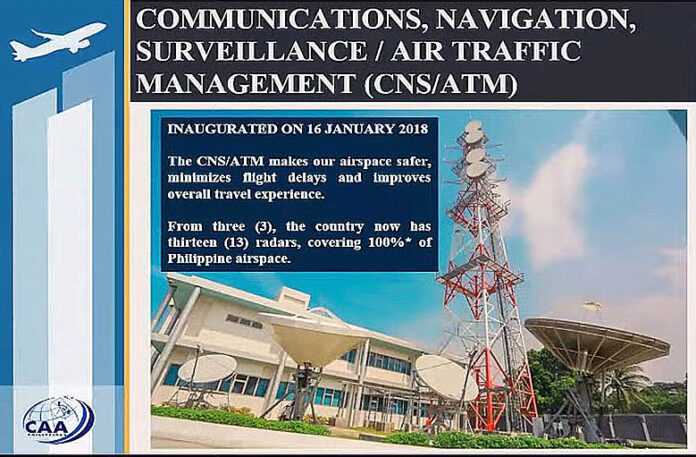
-
The failed communications, navigation, surveillance/air traffic management system at CAAP is still a state-of-the-art air traffic control suite but requires a software and hardware upgrade
-
CAAP director general Manuel Antonio Tamayo took full responsibility for the New Year’s Day shutdown at NAIA and other Philippine airports which halted hundreds of flights
-
CAAP will conduct a feasibility study for a “second independent system” or a backup for the CNS/ATM system
-
The civil aviation regulator is also negotiating with Thales, a partner in the joint venture that installed the system, to provide third-party service maintenance
-
Transportation Secretary Jaime Bautista vowed to fast-track resolution of the dispute between DOTr and Thales-Sumitomo
The Civil Aviation Authority of the Philippines’ (CAAP) communications, navigation, surveillance/air traffic management (CNS/ATM) system is still state-of-the-art but requires a software and hardware upgrade, CAAP director general Manuel Antonio Tamayo said.
Philippine airspace was shut down for a few hours on January 1 due to a power outage in the air traffic control system.
“The CNS/ATM at this point in time is still state of the art and a gold standard as far as air traffic control is concerned. It just needs [upgrading of] software and hardware,” Tamayo said during the January 12 hearing on the airspace mess called by the Senate Committee on Public Services.
Based on CAAP’s investigation, Tamayo said the outage was triggered by a faulty circuit breaker and not the system’s uninterruptable power supply (UPS) as initially reported.
He explained the UPS de-energized the CNS/ATM equipment at 9:49 am when it detected a flaw in the system – the damaged circuit breaker. The de-energizing was a security feature of the UPS to protect the equipment from further damage.
The Department of Information and Communications Technology-attached agency Cybercrime Investigation and Coordinating Center (CICC) conducted a parallel investigation of the incident on January 3 and ruled out a cyberattack.
Tamayo said CAAP still doesn’t know what caused the damage to one of the circuit breakers. He said the damaged circuit breaker and power transfer switch were turned over to the CICC for forensic investigation.
The CAAP chief took full responsibility for the New Year’s Day breakdown.
“On behalf of CAAP and DOTr [Department of Transportation], we again extend our sincerest apologies to all those who were inconvenienced and greatly affected by this circumstance, which is something we are not proud of,” Tamayo said.
“We take this as a lesson and we manifest to this honorable committee and fellow Filipinos that we take full responsibility and accountability for what happened,” he added.
“We commit to see through this ordeal and remain transparent in all our dealings and of service to the Filipinos in ensuring that our skies are safe,” Tamayo stated.
CAAP will conduct a feasibility study for a “second independent system” or a backup system for the CNS/ATM, he said. The study will cost around P200 million while the new system may cost as much as the existing CNS/ATM (about P10 billion).
Moreover, Tamayo said CAAP is negotiating with Thales, one of the joint venture partners that set up the CNS/ATM system, to provide third-party service maintenance. The maintenance warranty for the system expired in 2020. Maintenance works since then have been performed by CAAP personnel trained by the joint venture.
The French company supplied the CNS/ATM while its joint-venture partner, Sumitomo Corp. of Japan, completed the building and civil works for the project funded by loans from the Japan International Cooperation Agency.
Thales country representative Harry Nuske, however, said they are “not keen” on entering into a new contract with CAAP until existing claims are settled.
DOTr Undersecretary for Aviation and Airports Roberto Lim said Thales’ claims totalling P987 million include a suspension claim arising from the three-year pause in the CNS/ATM project from 2010-2013, a prolongation claim due to the prolonged suspension of the work, and an escalation claim.
The delays stemmed from the Commission on Audit’s disallowance of payments to the joint venture in 2011, a decision reversed in 2013.
Lim said DOTr created a claims committee in September last year to resolve the dispute and expected the first claim would be resolved this month, and the remaining claims in February.
Transportation Secretary Jaime Bautista vowed to fast-track the resolution of the dispute between DOTr and Thales-Sumitomo.
Meanwhile, to address the workforce gap for air traffic controllers, Bautista expressed support for legislation that will exempt CAAP employees from the salary standardization law to provide better benefits and salaries on par with those offered in the Middle East.
“We also support the bill that will exempt the employees of CAAP from the government salary standardization because we know that we need to retain these people, or else, they will leave the country, not because they don’t love the country, but for economic reasons. They also need to support their families and give their families a very good livelihood,” he said.




